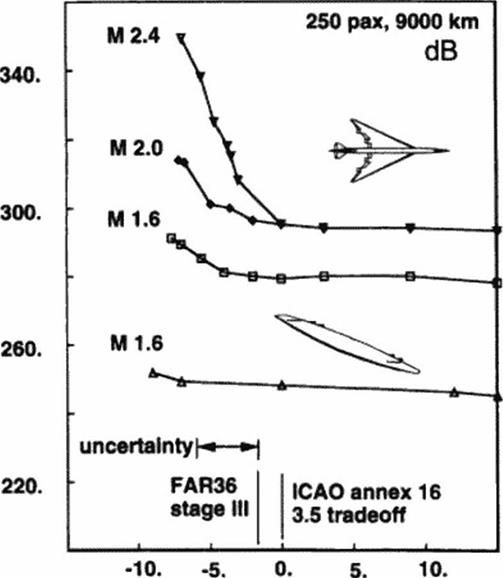. Technology Assessment
Evaluating the influence of new technologies on the aircraft design and get the benefits (or penalties) in the operating cost is a major part of the work in the future project office. Such studies were traditionally done by fixing all parameters and make a one dimensional analysis. But this approach docs not allow for second order effects which can compensate or enhance the influence of the parameter on the aircraft design. The MIDAS concept enables the project engineer to evaluate the consequences of technology introduction fast and considering all aspects of the global model.
For the supersonic transport of the next generation an optimistic maximum noise suppression level of approximately 14 dB must be taken into account for reaching the goal of FAR stage 3. The weight increase and the thrust loss due to the noise suppressor arc incorporated in
the model as ( 10 )0S’AdBj ^ loss of thrust and 5** increase in nacelle weight per dB of suppression. Figure 104 shows the change of Aff. if the technical target of the year 2005 w ill not be
achieved or surpassed. The OFW shows a relatively neutral behavior, due to his flexibility to compensate surpressor nonperformance by reducing thrust requirements. For the SWB a shortfall of the target will he fatal especially for Mach numbers over 2.0.
 |
 |
Figure 104 Effect of noise regulations
In ref. (374) further examples of technology assessment studies with MIDAS are
given.
Acknowledgements
The author would like to thank all the people at Deutsche Airbus SCT-team who contributed to make this project especially our project manager Dctlcv Renners and Dirk von Reith in Hamburg. Special thanks also to Prof. Kroo’s aircraft design group at Stanford University for their work on the Genic optimiration shell and to Prof. Yoda for her constructive editing.
17.5 Conclusion
In (his chapter we discussed a design strategy which given a mission finds the optimum aircraft design in the analysis parameter space. This parameter space is determined by the various disciplinary groups. Based upon this input robust physically correct analysis modules were developed. Improved non-linear optimization techniques were used to find the best design using these modules in this parameter space. This strategy reduced the number of design cycles and allowed us to evaluate more configurations. The ability to evaluate more configurations is essential for projects with high development cost that depend on the realization of aggressive technology targets. In the case of the supersonic transport this ability allowed us:
• to investigate a wide range of solutions to find one which will be flexible enough to compete in an unknown market 30 years from now.
• to build scenarios to find out what happens w hen the design requirements will change or technical targets cannot be reached
• to find out where wc have to invest work in detailed technology programs to get the best results.
The present method was used to study the relative performance of symmetric wing
body (SWB) and oblique flying wing (OFW) and oblique wing body (OWB) supersonic transports over a wide range of missions. The conclusions of this study where.
• Supersonic transports achieve their highest profit potential at Mach numbers between 1.6 and 2.0 and are able to compete with subsonic transports when adequate structural and noise reduction technology is available.
• Noise regulations and runway loads may limit the size of symmetric wing body configurations with cruise speeds over Mach 2.0 to 350 tons. Only with very aggressive technology assumptions will such a transport be able to transport 250 passengers across the pacific.
• It is possible to reduce the total operating cost per seat of supersonic tranpsports by increasing the payload size up the maximum that is allowed by runw ay load and noise constraints. Larger payloads use the available volume more efficiently for a given passenger cabin standard.
• The best oblique flying wings arc large and long range. They are compatible to the current traffic infrastructure, and not dependent on very aggressive technology assumptions. In addition. they produce less sonic boom and can comply with stage 4 noise regulations. [10]











